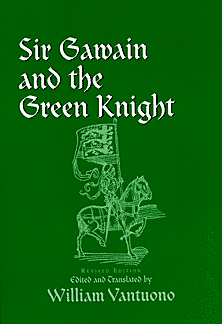In the thirteenth century when Sir Gawain and the Green Knight was written, as well as in the Arthurian era in which it took place, Christian traditions created a male-dominated society in which women had very little perceived power.
The paradigm of women in this era was a delicate paradox- they were treated with idolatry and reverence, but were not respected as capable beings in their own right.
Much of the chivalric code that knights prided themselves on was based on the assumption that women could not achieve much for themselves, and therefore men had to achieve it for them.
However, the plot of this poem indicates that women had the ability to attain their needs and exert their influence as they desired.
In the passage used for this paper, Gawain laments the mighty Biblical characters felled by women in justifying his own susceptibility to the wishes of Lady Bercilak.
Through the characters of Morgan le Fay and the Lady Bercilak (referred to as “The crone and the coquette”) one can witness the true power of women to achieve their ends through the manipulation of men even in the patriarchal society of Camelot (“Sir Gawain and the Green Knight” 1317). Sir Gawain’s speech to Lord Bercilak reinforces that women are the driving force of action in Sir Gawain and the Green Knight.
Many of the themes noted in Sir Gawain and the Green Knight are traditionally masculine ones- heroism, a quest, warlike conflict- but it is imperative to note that the genesis of the story would not have occurred if it was not for the ulterior motives of the woman, Morgan le Fay. Morgan le Fay is a sorceress who is Arthur’s half-sister.
She appears often in Arthurian literature, often as the lover of Merlin the wizard and others: “The mistress of Merlin, she caught many a man” (2448). Lord Bercilak tells Gawain that the reason he came to Arthur’s court in disguise was on her command, “She puts the shape on me to puzzle your wits/ to afflict your fair queen and frighten her to death” (2459-2460). One is not certain why Lord Bercilak is doing Morgan Le Fay’s bidding- it seems unlikely if not impossible that he would because of ‘courtly love’.
It is more probable that he is a man that she has “caught”, whether through physical attraction or through enchantments, “None holds so high degree/ her arts cannot subdue” (2454-2455). Although many reading this poem would say the major clash was between Sir Gawain and the Green Knight, these two men are only pawns in a larger conflict between the women Morgan le Fay and Queen Guinevere.
One of the key players in this larger conflict is Lady Bercilak. Ultimately the onus is on her to test Gawain’s virtues through temptation. Eventually, Gawain succumbs to her charms by accepting one of her gifts, a green girdle. While it seems that the feeling that Gawain has towards Lady Bercilak is mostly of a chaste courtly love, it appears he also has a physical attraction to her, “The faults and frailty of the flesh perverse/how its tenderness entices the foul taint of sin”(2435-2436).
Lady Bercilak takes advantage of Gawain’s attraction to her in order to control their interactions and use them for her purposes. It is clear in this passage that Gawain blames Lady Bercilak for his failure to adhere to the contract, “But if a dullard should dote, deem it no wonder/ and through the wiles of a woman be wooed into sorrow” (2414-2415). In his speech, Gawain acknowledges that he was outwitted by Lady Bercilak but given all of the great men who have also been bested by women he, “thinks [he] may be excused” (2428).
One can see the cunning of Lady Bercilak as she systematically explores and capitalizes on Gawain’s weakness- his fear of dying. She initially tries to give him a ring, but changes her tactics when she realizes he is not tempted by material goods. The gift of the green girdle assuages his fears and provides the opportunity for Lady Bercilak to show Gawain’s fallibility, and her own control over him.
In this passage, Gawain admits that he was outsmarted by Morgan le Fay and Lady Bercilak, “Both [Lady Bercilak] and that other, my honored ladies/that have trapped their true knight in their trammels so quaint” (2412-2413).
But these women were more than just intelligent players in the plot of the poem Sir Gawain and the Green Knight-they use their abilities and desires to fuel the events of the story. These women are examples of how women can possess freedom and control even within the highly constraining, patriarchal construct of medieval times.

